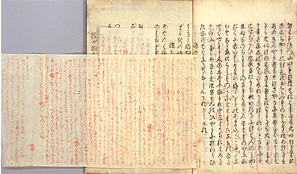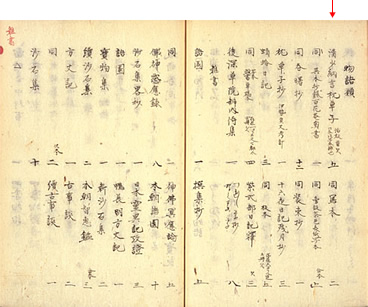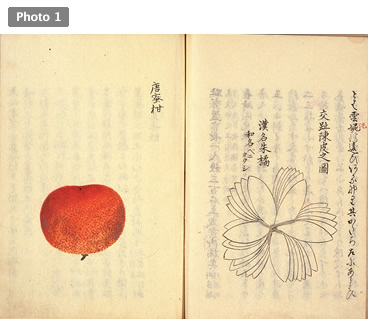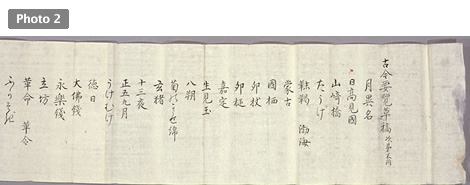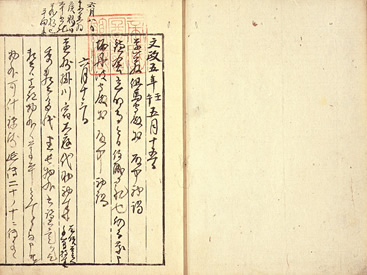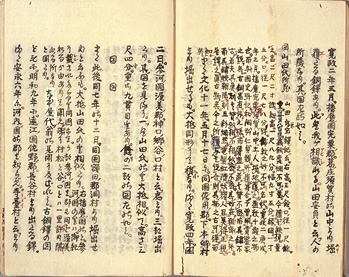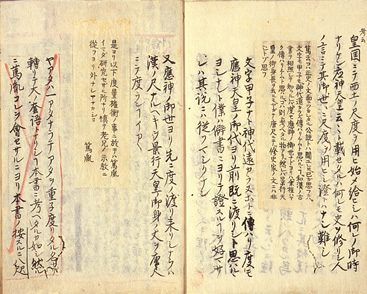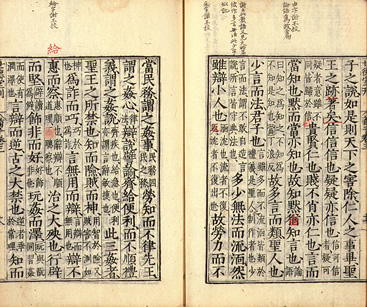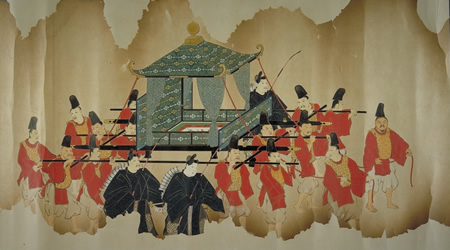A collection of essays written by Sei Shonagon (compiled at the end of the 10th century or the beginning of the 11th century). Old movable-type edition. Yashiro Hirokata (1758 to 1841), a scholar of ancient Japanese way of thinking and spirit in the late Edo Period, produced this book by collating different versions.
Home > 2. Intellectual Exchange > Research and Intellectual Exchange of Scholars
In the Edo Period (1603 to 1867), books were widely distributed, which enabled educated people to study on their own without learning from masters. Not a few materials of that time still show the evidences of such people's research activities. Book collectors, who possessed numerous books, also appeared in this period. Publishing and book-lending businesses become popular, and books filled with stories to entertain ordinary people were published. Some of the popular story writers generate bestsellers and earned much money.
In Section II, we focus on the late Edo Period, where scholars and popular story writers worked energetically. We display good evidences that show their activities from the rare and valuable books possessed by NDL.
30. Makura no soshi
- 5 volumes, printed in the Kan'ei
Era (1624 to 1644), 5 books, 27.5
 19.0cm <WA7-84>
19.0cm <WA7-84>
31. Shinobazu bunko shojaku mokuroku
- copied in the late Edo Period(19th century),
8 books, 23.4
 16.4cm <123-7>
16.4cm <123-7>
This is a catalogue of "Shinobazu Library," Yashiro Hirokata's private collection. More than 10,000 titles are listed. The materials marked with ![]() are exhibited in 30.
are exhibited in 30.
32. Kokon yoran ko part of plants and trees: mandarin orange tree 1
- edited by Yashiro Hirokata, copied in the
late Edo Period (19th century),
1 book, 26.6
 18.9cm <
18.9cm < 7-125>
7-125>
This is a part of encyclopedia-like books edited mainly by Yashiro Hirokata under an order from the Edo Shogunate. A series of these books were prepared for studying origins and histories of Japanese objects, but this attempt was not completed due to the death of the chief editor, Yashiro. Photo 1 shows a part of an illustrated mandarin orange tree. Photo 2 indicates the beginning part of the early list provided for the Edo Shogunate.
33. Suiba shoroku
- by Yashiro Hirokata in the 5th year
of the Bunsei Era (1822), 1 book, 22.0
 15.8cm <WA27-10>
15.8cm <WA27-10>
A diary of the 5th year of the Bunsei Era (1822) written by Yashiro Hirokata. This diary vividly shows how he cultivated friendships with his fellow scholars.
34. Konin rekiunki ko
- drafted by Hirata Atsutane, revised by Hatano
Takao, et al., written around the 7th year
of the Tenpo Era (1836), 1 book, 24.7
 17.4cm <WA18-27>
17.4cm <WA18-27>
This is a manuscript of the book written by Hirata Atsutane (1776 to 1843), a scholar of ancient Japanese thought and culture, in which Konin rekiunki (annual listing of nobles) was studied and annotated.
35. Honchodoko yatanokagami setsu Hiratashi hikoben
- by Kariya Ekisai, written in the 2nd year
of the Tenpo Era (1831), 1 book, 24.6
 17.4cm <
17.4cm < 9-1>
9-1>
Kariya Ekisai (1775 to 1835), a scholar of old documents, offered a counterargument against Hirata Atsutane, who criticized Ekisai's "Honchodoko," where he studied ancient units of length.
36. Junshi (Xun zi)
- 20 volumes; volume I and volume II are missed, noted by Yang Liang (of the Tang Dynasty, China), printed by Kasai Ichirobee (of Kyoto) in the 2nd year of the Enkyo Era (1745), 9 books, 22.8
 16.7cm <
16.7cm < 2-2>
2-2>
An annotated book of Xun zi, one of the Chinese classics, was printed in Japan. Kariya Ekisai made a comparison with the version from the Song Dynasty of China which he possessed.
37. Yoshazu ko
- written by Matsudaira Sadanobu in the 1st year of the Bunka Era (1804), 3 scrolls, 34.4-34.7cm in length <WA31-10>
Matsudaira Sadanobu (1758 to 1829), a famous politician and a man of culture, copied the descriptions and pictures of palanquins and cow carriages used in the past, including ancient times, from old books for study. Some parts of the original materials were destroyed by fire; these scrolls are re-edited one based on their survived parts.


